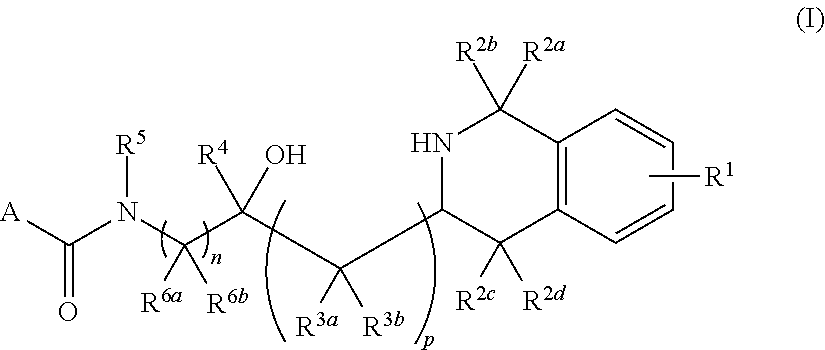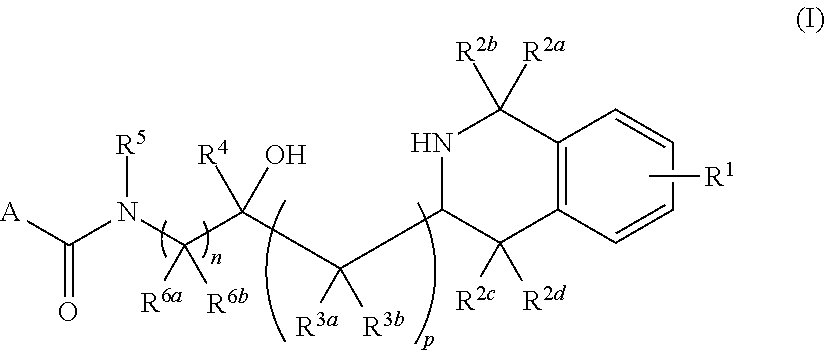Tetrahydroisoquinoline derived prmt5-inhibitors
a technology of tetrahydroisoquinoline and inhibitors, which is applied in the field of tetrahydroisoquinoline derived prmt5 inhibitors, can solve the problems of elusive mechanisms, and achieve the effects of reducing arginine-methylated p53, synergizing well, and modulating p53 activity
- Summary
- Abstract
- Description
- Claims
- Application Information
AI Technical Summary
Benefits of technology
Problems solved by technology
Method used
Image
Examples
example 1
oxy-3-(1,2,3,4-tetrahydroisoquinolin-3-yl)propyl)-4-(morpholine-4-carbonyl)benzamide (1)
[0699]
(a) 1-Amino-3-(isoquinolin-3-yl)propan-2-ol (A1)
[0700]2-(2-Hydroxy-3-(isoquinolin-3-yl)propyl)isoindoline-1,3-dione I3 (114 mg, 0.343 mmol) and absolute ethanol (5 mL) were brought to 80° C. Hydrazine hydrate (0.25 mL, 8.0 mmol) was added and the mixture stirred at 80° C. After two hours, the heterogeneous mixture was cooled to room temperature, diluted with cold absolute ethanol (5 mL) and filtered. The collected solids were washed with cold ethanol (2 mL) and the combined filtrates were concentrated. The residue was dissolved in absolute ethanol and concentrated in vacuo three times to give the desired compound as a pale yellow syrup (70 mg, quant.). The material was taken onto the next step without further purification. 1H NMR (400 MHz, d4-methanol) δ 9.19 (s, 1H), 8.22-8.16 (m, OH), 8.08-8.02 (m, 1H), 7.89-7.83 (m, 1H), 7.79-7.73 (m, 1H), 7.71 (s, 1H), 7.66-7.59 (m, 1H), 4.11-4.03 (m, 1...
example 2
oxy-2-(1,2,3,4-tetrahydroisoquinolin-3-yl)ethyl)-4-(morpholine-4-carbonyl)benzamide (2)
[0703]
(a) 2-Amino-1-(isoquinolin-3-yl)ethan-1-ol (A3)
[0704]2-(2-Hydroxy-2-(isoquinolin-3-yl)ethyl)isoindoline-1,3-dione I5 (50 mg, 0.16 mmol) was dissolved in ethanol (1 mL) and hydrazine hydrate (0.050 mL, 0.79 mmol) was added. The mixture was heated at 80° C. for 3 hours and allowed to cool. The mixture was filtered and the solid was washed with further ethanol (2 mL). The combined filtrates were concentrated to give the desired compound as a yellow syrup (32 mg, >100% yield). The material was carried forward without further purification: LCMS-B: RT 2.06 min; m / z 189.2 [M+H]+.
(b) N-(2-Hydroxy-2-(isoquinolin-3-yl)ethyl)-4-(morpholine-4-carbonyl)benzamide (A4)
[0705]2-Amino-1-(isoquinolin-3-yl)ethan-1-ol A3 (32 mg, 0.16 mmol), DMF (1 mL), 4-(Morpholine-4-carbonyl)benzoic acid I7 (48 mg, 0.20 mmol), DIPEA (0.059 mL, 0.34 mmol) and HATU (97 mg, 0.26 mmol) were stood at room temperature. After 3 hours...
examples 3-29 , 57-89 , 111-120 and 126 (table a)
Examples 3-29, 57-89, 111-120 and 126 (Table A)
[0707]
[0708]Method AA:
[0709]The respective carboxylic acid (0.070 mmol), triethylamine (0.019 mL, 0.14 mmol), tert-butyl (S)-3-((R)-2-amino-1-hydroxyethyl)-3,4-dihydroisoquinoline-2(1H)-carboxylate (I12) (20 mg, 0.068 mmol), DMF (0.5 mL) and HATU (39 mg, 0.10 mmol) were stood at room temperature. After 17 hours, water (1.5 mL) and DCM (1 mL) were added, the mixture agitated then passed through a phase separation cartridge. The collected DCM phase was diluted with 4.0 M HCl in 1,4-dioxane (1 mL), stood for 2 hours then loaded onto a 0.5 g SCX cartridge. The cartridge was washed with methanol (10 mL) then eluted with 2M ammonia in methanol (10 mL). The basic eluate was concentrated to afford the amide product.
[0710]Method AB:
[0711]To a solution of the respective acid (0.17 mmol, 1 equiv) in DMF (2 mL) and MeCN (2 mL) were added DIPEA (89 μL, 0.51 mmol, 3 equiv), HATU (97 mg, 0.26 mmol, 1.5 equiv) and a solution of tert-butyl (S)-3-((R)-2-...
PUM
| Property | Measurement | Unit |
|---|---|---|
| particle size | aaaaa | aaaaa |
| concentration | aaaaa | aaaaa |
| concentration | aaaaa | aaaaa |
Abstract
Description
Claims
Application Information
 Login to View More
Login to View More - R&D
- Intellectual Property
- Life Sciences
- Materials
- Tech Scout
- Unparalleled Data Quality
- Higher Quality Content
- 60% Fewer Hallucinations
Browse by: Latest US Patents, China's latest patents, Technical Efficacy Thesaurus, Application Domain, Technology Topic, Popular Technical Reports.
© 2025 PatSnap. All rights reserved.Legal|Privacy policy|Modern Slavery Act Transparency Statement|Sitemap|About US| Contact US: help@patsnap.com



